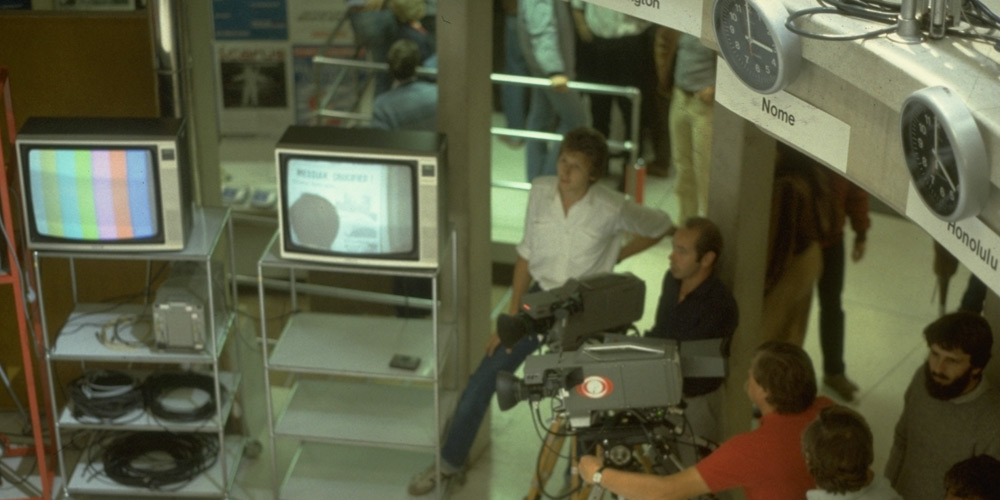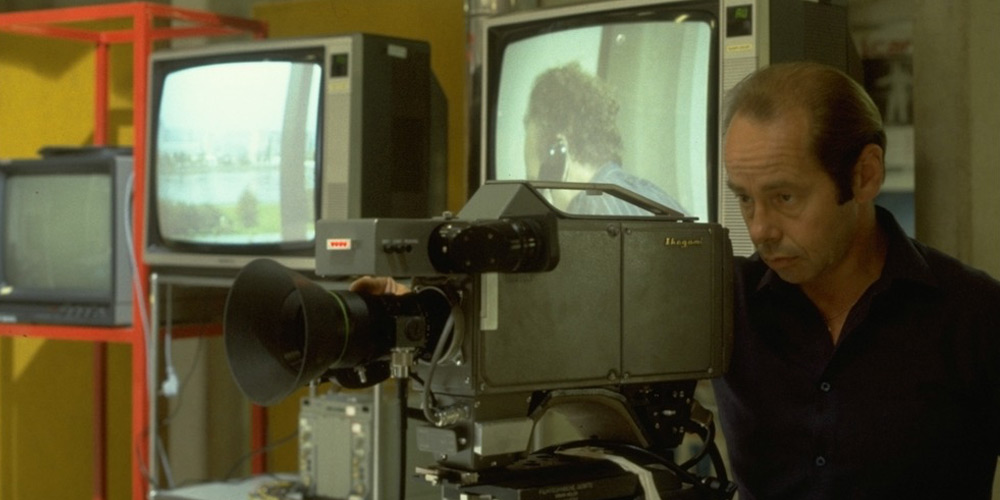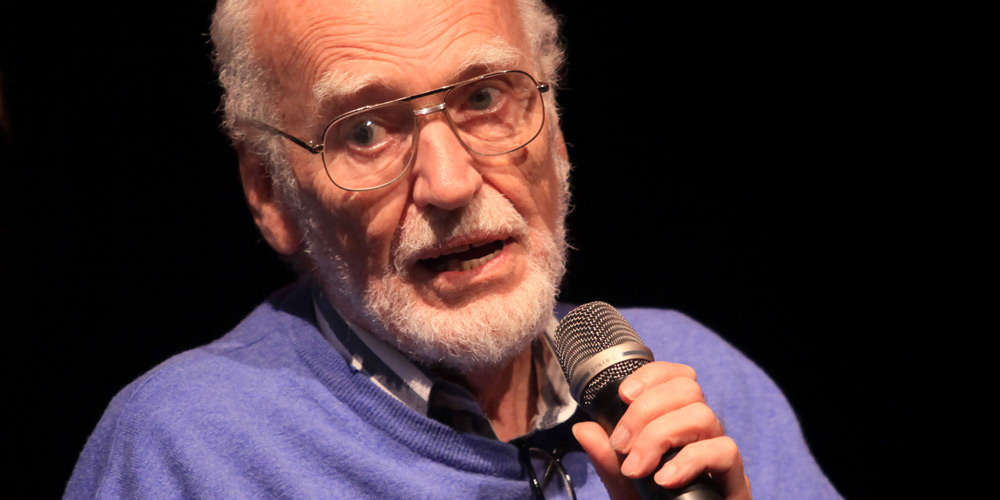Artist Robert Adrian X already began dealing with the phenomenon of computer users linking up in networks over 30 years ago in “The World in 24 Hours.” Now, Ars Electronica is showcasing this seminal 1982 work as a fitting way of congratulating the artist, leading-edge thinker, media art pioneer, telecommunications artist, painter and sculptor on the occasion of his 80th birthday on February 22. Manuela Naveau, a curator and project manager at Ars Electronica, had an opportunity in late 2013 in Vienna to sit down for a chat with the Canadian artist together with his partner Heidi Grundmann, arguably the most prominent developer and promoter of radio art in Austria.
On Simultaneity in “Electronic Space”
I wanted to know more about the time in which it couldn’t yet be taken for granted that everyone simply knew what the word networking [in the sense of connecting with other people via computers] means. What do networking and the internet refer to here? “In any case, it’s all about the telephone,” Robert Adrian X stated right at the start of our chat. The development of the telephone—whereby, for the first time, transmitter and receiver functioned simultaneously—was the genesis of the internet. And even in the 1970s and early ‘80s, there were still other terms to designate this—people referred to telecommunications and to electronic space. We were aware that there existed something like the internet (see ARPANET 1969), even if we didn’t have a clear conception of how it worked or what an influence it would be exerting on our culture in general. We knew that this was no longer a matter of communicating with a single party like in a telephone conversation; that you could be in contact with several people at the same time. But what did this simultaneity actually mean in an invisible reality? Does it exert an influence on our worldview and, if so, how does it influence us today?

Photo: Sepp Schaffler
When Linz Got Linked Up in a Network with Other Cities
Amidst fascination with such questions, Ars Electronica Linz commissioned Robert Adrian X to conceive and produce “The World in 24 Hours.” From 12 Noon on September 27, 1982 until 12 Noon the next day, 15 cities worldwide were interconnected in conjunction with the Ars Electronica Festival. The point was to jointly explore this new electronic space with the help of the telecommunications media available at the time. The idea was to simultaneously utilize five telephone lines (three of which ultimately proved to be functional as planned). During this 24-hour period, participants could send artistic statements and also exchange coordination information via telephone, FAX, slow-scan television (SSTV) and ARTBOX, the international computer mailbox system (initiated by Robert Adrian X and subsequently dubbed ARTEX – The Artists’ Electronic Exchange Program), which was based on a conference system developed by the I.P.Sharp (IPSA) company. The salient criteria were that the respective technologies had to be more or less accessible, relatively affordable, simple to use, and could be implemented in a way that was acceptable to Austria’s Post and Telegraph Administration.
ARTEX – A Network for Artists
“The World in 24 Hours” wasn’t the first live telecommunications project. It was, in fact, based on experiences that artists such as Douglas Davis and Nam June Paik had already gained in the 1970s in telematic projects via satellite. And there had already been computer telecommunications projects—for instance, Bill Bartlett’s “Interplay” in Toronto in 1979, and The Artist’s Use of Telecommunications Conference in 1980 at SFMOMA, which Robert Adrian X had been involved in. Indeed, the experiences gained in these projects were precisely what inspired Robert Adrian X to collaborate with Bill Bartlett in 1980 to develop ARTEX. The two artists, neither of whom was affiliated with a university, had to line up access to the equipment and networks on their own, as well as, often, privately raise no small amount of funding. Enthused by the idea of communicating with other artists worldwide, Robert Adrian X collaborated with Gottfried Bach, then an IPSA manager in Vienna, on an economical, user-friendly e-mail program for artists. In 1980, this went down in history as one of the first online platforms or, more precisely, a user group for artists.
“Right for the outset, my principle was to set up a network that was simultaneously a communications web and a medium for the exchange of ideas.”
In the 1990s, this would be referred to as a chat room; today, we’d call it a social media platform for artists. Nevertheless, in the ‘80s, a term hadn’t emerged yet to designate this new form of networking. 30 to 35 artists and researchers were listed on ARTEX. And Robert Adrian X intuitively knew that as soon as access to the new electronic space became available, this would also bring about changes—which he wanted to explore in “The World in 24 Hours.”

Photo: Sepp Schaffler
When you turn off the machine, the space disappears
Robert Adrian X: “In the late 1970s, you suddenly felt that the whole power structure had shifted into electronic systems, and thus into electronic space. I mean, as soon as the machines are switched on, the FAX system functions, computer communication works, these companies come into existence. The companies exist only in this virtual space. Only if the machines are switched on, if the electronic system establishes connections, then and only then does Volkswagen, for example, exist. Otherwise, if the machines aren’t running, they’re just a bunch of smaller or larger factories.”
“But all the money, everything runs via invisible networks. And artists who work with the network can make at least part of this network visible. After all, it’s clear that art is a visual affair. If you enter a network and do art in it, you have to display something there.”
“This was the concept of communications sculpture. This means that, for me personally, ‘The World in 24 Hours’ was a piece of sculpture. You’re not just creating the space. No, this is a matter of a sculptural problem: space, spatial manipulation, the depiction of space, etc. And in these systems, if two people exchange a work of art with one another on the telephone, then this space constitutes a work of art, a sculpture, as long as the machine is on. When you turn off the machine, the space disappears, and then the work of art is gone too. Just like Volkswagen is gone.”
An Experience for Everyone
But Robert Adrian X didn’t want this initial experience of being linked up in a network to be the exclusive purview of companies and institutions. Although he had no direct access to universities—to say nothing of the military—he wanted to open the technology up to people and especially artists, who were to be given the opportunity to gain experience and to discover a form of translation, of visualization of something that had begun to emerge in the realm of the invisible. In answer to my question of the extent to which this space is determined by the devices themselves or by the human beings behind the apparatuses, Robert Adrian X gave an account of a very personal experience:
“I had this on my wall for a long time, this headline on the front page of the Kronenzeitung [Austria’s leading tabloid] a few years ago during the [soccer] World Cup, I believe it was in Japan: Six Billion in Front of the Screen! And suddenly you had this image in mind: 6,000,000,000 people watching the same telecast. Not just all of them watching TV; they’re all seeing the same image at the same time. And this was the moment when this space suddenly became clear to me—everyone sitting in approximately the same position, watching the same picture. And then, all at once, you had terms with which to grasp this media space.”
Images of a Surveillance Camera in the Living Room
Robert Adrian X had already begun dealing with the significance of these new, electronically implemented spaces at an early stage of his artistic career—for instance, a 1981 live intervention entitled Surveillance/Überwachung in which he maneuvered images captured by a surveillance camera installed in the Karlsplatz subway station in downtown Vienna into Austrians’ living rooms, where they appeared live on June 16, 1981 during the 6-10 PM time slot among the ORF – Austrian Broadcasting Company’s regularly scheduled programming. Asked about precisely where opening things up to the general public in this way had been positioned on his agenda, Robert Adrian X said:
“The most important thing was that artists had struggled to gain access to the media. But the point wasn’t reaching a mass audience; this was a matter of the medium, a confrontation with the medium in and of itself. Thus, the essence was media critique within the media.”
Heidi Grundmann added her thoughts about “The World in 24 Hours.” “And this type of project didn’t have anything to do with the audience either. The point was: you were either a participant or you weren’t. After all, there’s nothing to see. There’s no performance, no communication. This process of mutual exchange engendered something that can’t be called a work, since it’s actually a matter of the dissolution of both the work and of the author. And that alone dictates that there can’t be an audience either.”

Photo: Sepp Schaffler
One of the World’s First Collaborative Writing Projects
“The World in 24 Hours” has garnered a place in the historiography of media art as one of the world’s first collaborative writing projects in the electronic sphere. It’s also likely to have been the first project in which the global network of amateur radio operators was involved. Asked how he sees his contribution to media art history and how the collaboration with ham radio operators proceeded, Robert Adrian X declined comment and provided an account that concluded with a wink of the eye:
“In my opinion, Roy Ascott’s 1983 work “La Plissure du Texte” was the first collaborative writing project. But since ARTEX already existed for “The World in 24 Hours,” you can regard it as a writing project because it constituted ongoing written communication via ARTEX—thus, a 24-hour-long chat, so to speak. And the thing about amateur radio is that hams are basically prohibited from exchanging information. You’re not even allowed to report how the weather is. And no one’s allowed to listen in to a transmission, not even the ham’s own wife. Generally speaking, the only devices that are permitted to be hooked up are those that the telecommunications agency can monitor. This means that when a device is authorized, the agency has to have one too. So the authorization process can take a while. We ultimately received a license for “3rd Party Participation,” a hookup in the public sphere in accordance with the regulations governing amateur radio as a sort of immaterial, de minimis exception. So then, we finally were provided with a definition of art: Art is negligible.” Robert Adrian X chuckled while lighting another cigarette.

Photo: Sepp Schaffler
A Technology Developed for Institutions and Firms
In retrospect, the artist pointed out that the project had been beset by a few additional problems: 1) only “industrialized, capitalist” countries could take part, 2) the high costs of the telephone transmission, 3) the necessity that the network of artists be reconstituted for each project, and 4) the trend towards institutionalization of access by artists to telematic systems. Robert Adrian X wrote in 1989, and thus seven years after the project had been produced, that the assumptions upon which “The World in 24 Hours” had been based proved to be “naïve.” (Adrian X, Robert, Elektronischer Raum, in: Kunstforum International. Im Netz der Systeme, Bd. 103, 1989) He noted that the costs incurred for the purpose of data transmission did not drop as had been assumed. Although the equipment to produce the data developed rapidly and the quantity of data got bigger and bigger, the costs of telephone transmission nevertheless rose. In 1989, he also wrote about a sort of powerlessness that overcame him and his fellow artists and that had to do with the closed nature of the systems.
“One quickly realized that the technology—with the exception of electronic games and the entertainment sector—was developed for the ‘corporate user’—that is, for institutions and firms.”
Robert Adrian X went on: “Individual users are excluded from the development of new technologies because they have no precisely definable needs, so it’s simply assumed that their interests are served by firms that, in turn, are interested in marketing spinoffs of complex technologies, and prefer to satisfy existing needs than to play a role in the development of potential alternative directions in electronic technologies. If there’s any chance at all to develop new technologies by means of which private users can make sensible use of electronic systems in order to exercise their right to genuinely participate in the development of this electronic world, then we have to take advantage of this opportunity at a very early stage. Now, it’s probably already too late to change the direction of the planning and development, but we can at least attempt to discover ways in which we can enable human content to flow into the commercial-military world floating amidst this electronic space.”
Over the course of this interview with the artist, it emerged that Robert Adrian X still maintains his very critical attitude towards seemingly open systems, and calls into question the internet as we know it today. In the early ‘90s, it was by no means certain “that the Post [Austria’s state telephone service provider] would ever relinquish its monopoly and the internet would even be permitted. After all, the internet already existed then, but it was accessible only by the military and universities. It eventually was opened up beginning in 1994, but it functioned totally differently than we had hoped. After all, in 1994-95, we had the feeling that we had a system that was open to the world, but we were quickly disabused of that notion over the next five years. What came of it was a totally commercialized, and thus closed, system.”
“Nobody knows what it’s all about”
In response to my final question concerning how we’ll be dealing with our more or less newly networked reality in the years to come, the artist stated:
“Nobody knows what it’s all about. You can’t analyze the past and extrapolate the trajectory into the future. Hegel has nothing to say about this, since you can’t trust people who’ve never used a telephone. This simultaneity we have now, this is totally new. And the devices are getting increasingly invisible, just like the internet itself is invisible. And it’s simply difficult for us to theoretically deal with this situation.”
“We still think like we did in the Industrial Age, like in an industrial society, in a mechanical world in which things intermesh like gears. Back then, it was a matter of speed, but that’s not the point anymore. Speed is a conception from another day and age, since there’s no longer anything that moves in these systems. There are no sequences any more. Cause and effect, these clear terms we have—they don’t function exactly the same way they used to. We have to reconceptualize this today. The beauty of this is also what’s problematic about it: it all looks the same; but inside, everything has changed.”
